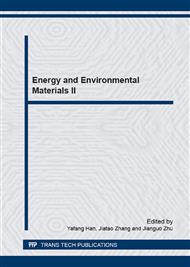p.137
p.144
p.153
p.161
p.167
p.173
p.178
p.185
p.191
Preparation and Photocatalytic Property of Dendritic TiO2/VOx Nanofibers
Abstract:
TiO2/VOx nanofibers were synthesized via electrospinning and dipping technologies. They increased the photocatalytic property by reducing the recombination rate of electrons and holes at the surface of TiO2. The composition, structure and morphology were characterized. The effect of annealing temperature to the dendritic structure and their photocatalytic property were demonstrated. The results showed dendritic TiO2/VOx nanofiers were obtained via dipping in vanadium sol, which was annealed at 550°C in 90% Ar/10% H2 atmosphere. The average diameter of the samples was 354±42nm. Both the size and the number of dendritic structure were increased as the annealing temperature was rising. The degradation rate of methyl orange (5mg/L) by as-prepared TiO2/VOx nanofibers was 76.4% after exposure under UV light for 120min, which was 25.7% higher than which annealed in air atmosphere.
Info:
Periodical:
Pages:
167-172
Citation:
Online since:
March 2015
Authors:
Keywords:
Price:
Сopyright:
© 2015 Trans Tech Publications Ltd. All Rights Reserved
Share:
Citation:


